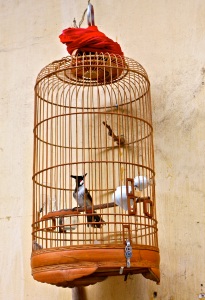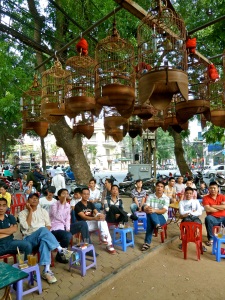
Thank you to Jura Cullen for the photos. More of her work can be seen at http://juraphotos.com/
Delicately adorned cages hang from a tree on the bank of one of Hanoi’s many lakes. Barely audible above the roaring traffic, a fragile tweet glides across the water. It is a sight and sound familiar to all those who have spent time in Vietnam. Undeniably romantic, the caged birds are both beautiful and tragic. A remnant of ‘old Hanoi’ – a slower, quieter version of the city – this image is one only perceivable at certain times and in certain places, such as misty lakeside mornings.
Yet whenever I see these birds, I can’t help but hear Alicia Keys’ song Caged Bird:
That’s why I say that I know
Why the caged bird sings
Only joy comes from song
She’s so rare and beautiful to others
Why not just set her free?
So she can fly, fly, fly
Spreadin’ her wings and her song
Let her fly, fly, fly
For the whole world to see
Perhaps I’m being a little dramatic. Keys is singing about the pressures of fame, and the Maya Angelou poem upon which it is based connotes racism and oppression. Hanoi’s bird owners, however, would vehemently deny any cruelty on their part and likely be offended by the insinuation that they do not care for their birds’ welfare and happiness. Still, the symbol of the caged bird is a powerful one.
“In Vietnam, the sight of bird cages paints the traditional picture of a rich man relaxing with his birds,” says Le Quy Minh, an expert on native bird life and one of Vietnam’s leading birders. “Birds are expensive and time-consuming and those that keep birds do so to show that they are able to lead the life of a relaxed, romantic, rich man.”
However, Minh argues that just because song birds are perceived as a part of Vietnam’s long history and rich culture, this time-honoured tradition doesn’t make the act of keeping them as pets right.
Sing like a bird…
 A friend who had been privy to the famous bird singing competition hosted by the Thien Quang Lake Bird Club recently explained a few of the particulars in bird care and competitions. Not only do birds require special food and grooming with warm water twice a day but the process of training a bird to sing beautifully is one of great care and technique.
A friend who had been privy to the famous bird singing competition hosted by the Thien Quang Lake Bird Club recently explained a few of the particulars in bird care and competitions. Not only do birds require special food and grooming with warm water twice a day but the process of training a bird to sing beautifully is one of great care and technique.
Young birds are placed near the elder birds so they can learn from their superiors. It is important, however, not to put them too close. The young winged pets risk not only straining their voices when they try to match their superiors but they may also become self-conscious in their lesser ability, causing them to suffer an inferiority complex and rendering the birds mute. Unable to compete in the prestigious competitions, these creatures become essentially useless to their owners.
Learning about all the care and support made me almost believe that the life of a songbird is not so bad. After all, owners are spending considerable time and money ensuring the birds’ welfare; surely they only want the best. They love the birds. They dote on them. These pets can be worth thousands of dollars, with rumors of particularly rare birds selling for over a billion Vietnam dong (near USD $500,000). And then there is the cage, an often elaborate work of art crafted out of anything from bamboo to elephant tusk for materials. There is even a Vietnamese saying that developed from this: “Valuable birds have to live in beautiful cages.”
But then I remember that these birds were once free.
“The majority of song birds are captured from the wild,” explains Minh. “It is believed that wild birds have stronger and more beautiful voices, as they have grown up hearing the sounds of nature.” Now kept in cages and trained to compete in competitions, they are no longer free; even the most beautiful cage is still a prison.
“People need to change their mindset. Just because it’s a small part of our history, it doesn’t make it right and it doesn’t mean we can’t change,” says Minh. “You don’t see people walking instead of driving a motorbike just because walking is more traditional. Bird owners can find new hobbies.”
Despite the beauty of the bird cages lining Hanoi’s streets and my fascination with the culture of bird keeping, I can’t help but agree wholeheartedly when Minh says that it is always “nicer to see the bird fly freely”.
This article first appeared on the AsiaLife website on April 19th 2015, click here to see the original.


How about posting some audio or video of these birds singing?